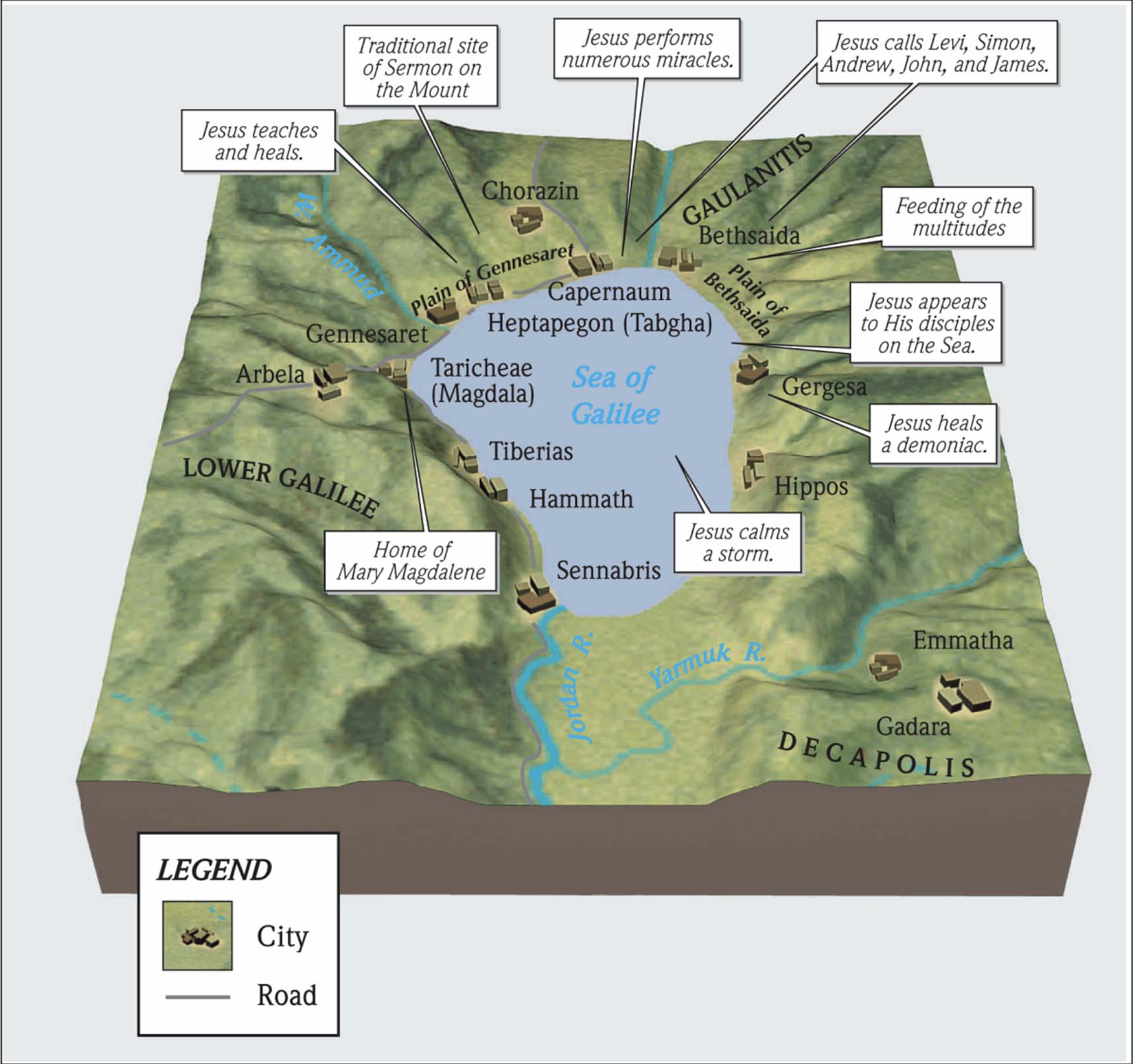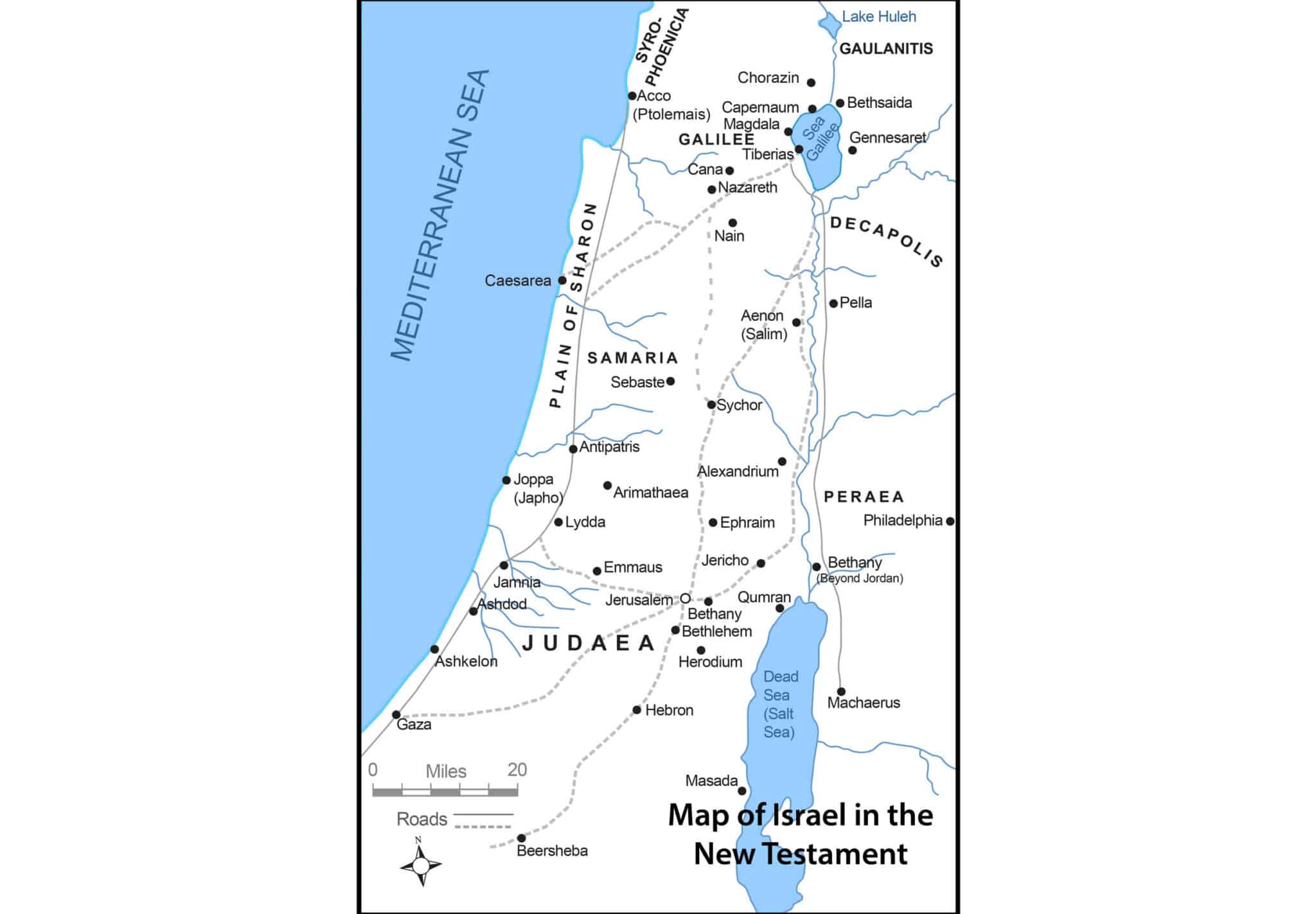Jesus begins traveling through the region of Galilee into all the cities and villages. He teaches in the synagogues, proclaiming the gospel of the kingdom and healing everywhere He goes. He feels compassion for the people who were discouraged and confused. He tells His disciples that the harvest for the gospel is bountiful, but there are few workers. He asks them to pray for God to send out more workers into His harvest.
The parallel account of Matthew 9:35-38 is found in Luke 10:2. A similar, but not quite parallel, event is described in Matthew 14:13-14, Mark 6:32-34, Luke 9:10-11, and John 6:1-3.
Having introduced and established the Pharisees as Jesus’s main earthly opposition, Matthew ends this chapter summarizing the next season of Jesus’s ministry. Jesus was going through all the cities and villages, teaching in their synagogues and proclaiming the gospel of the kingdom, and healing every kind of disease and every kind of sickness (v 35). This remark also serves as a transition and introduction for the next chapter when Jesus sends out His disciples through Israel to proclaim the kingdom.
With the exception of Jesus’s brief excursion to the other side of Galilee (Matthew 8:23-34), all of the miraculous events—Jesus’s calling of disciples, the Sermon on the Mount, and His personal encounters recorded between Matthew 4:12-9:34—appear to have taken place near the northern shore of Galilee, specifically in or near the town of Capernaum. This is about to change.
All the cities and villages that Jesus was going through are left unnamed. Perhaps Jesus went on a circuit throughout the towns and villages of the greater Galilee region, or beyond. This seems reasonable based on Matthew’s similar summary at the beginning of Jesus’s public ministry, where the author specified that Jesus was going all throughout Galilee (Matthew 4:23). He offers no regional qualification here at the end of chapter 9.
Matthew has suggested an unstated gap in time between the preceding events and the ones that follow. It is possible that some of the events recorded in the gospel of John such as Jesus traveling to Jerusalem for the Passover (John 2:13), His clearing the temple for the first time (John 2:14-20), His interview with Nicodemus (John 3:1-21), His encounter with the Samaritan woman at the well (John 4:1-38), the healing of a nobleman’s son in Cana (John 4:46-54), and His healing of the paralytic by the pool in Bethesda (John 5:1-9) may have occurred during this period.
While we do not know for certain which towns Jesus was going through or how long He was going through them, we do know what He was doing as He went through them. He was doing three things: teaching in their synagogues; proclaiming the gospel of the kingdom; and healing every kind of disease and every kind of sickness (v 35). All three of these actions—teaching, proclaiming, and healing—are present-active-participles in Greek. Their form indicates that they were continuous and repetitive actions Jesus was constantly doing during this season of His ministry.
Synagogues were cultural gathering places where the Law and Jewish tradition were taught by the local scribes and Pharisees. Synagogues were locally run and organized. Each village had its own synagogue; larger Jewish towns and cities had several. And each synagogue belonged to the local community of Jews who attended it. That’s why Matthew writes their synagogues. The synagogues belonged to the people. The main meeting times of synagogues took place on the Sabbath. Services likely included prayer, readings and recitations of the Law and the Prophets, and some form of teaching or preaching. The gospel writer Luke provides a glimpse of one occasion where Jesus preached in the synagogue of His hometown of Nazareth (Luke 4:15-30). Jesus was invited to teach in their synagogues. And He was continuously teaching in their synagogues in all the cities and villages that He was going through (v 35).
In addition to teaching in their synagogues, Jesus also was constantly proclaiming the gospel of the kingdom (v 35). This was His central message. Matthew already detailed what might have been a synopsis of the core message Jesus was proclaiming about His kingdom through his publication of the Sermon on the Mount (Matthew 5-7). Jesus was likely proclaiming this gospel of the kingdom as He was teaching in their synagogues (v 35). But He was also proclaiming it as He spoke parables and interacted with the people He encountered along the roads, on the hillsides and groves, and in the houses wherever He went.
Finally, Jesus was continually healing people from every kind of disease and every kind of sickness in all the cities and villages He was going through (v 35). Matthew has already given examples of some infirmities Jesus healed. They include leprosy, paralysis, fever, blindness, bleeding, muteness, and demonic possession.
Seeing the people, He felt compassion for them (v 36). Everywhere He went, Jesus looked to love and serve people, including sometimes confronting them. He no doubt experienced physical exhaustion or social fatigue. But Jesus was motivated to keep obeying His Father in heaven (John 5:19, 8:28) and constantly serve the people. Jesus felt compassion for them, because He saw how they were distressed and dispirited (v 36).
Their distress indicates their life was difficult. Life was hard. It was especially hard without the comforts we have in modern life. The people Jesus saw were burdened by the natural difficulties and frailties of life, such as hunger, thirst, disease, pain, grief, and death.
But they were more than distressed about how to overcome these trials. They were also dispirited. Perhaps they felt hopeless beneath the imperial oppressions from Rome and the spiritual oppression from the Pharisees and Sadducees, who “tie up heavy burdens and lay them on men’s shoulders, but they themselves are unwilling to move them with so much as a finger” (Matthew 23:4). It was to people who were distressed and dispirited (v 36) that Jesus will later implore,
“Come to Me, all who are weary and heavy-laden, and I will give you rest. Take My yoke upon you and learn from Me, for I am gentle and humble in heart, and you will find rest for your souls. For My yoke is easy and My burden is light.”
(Matthew 11:28-30)
Jesus saw that they were like sheep without a shepherd (v 36). The phrase describing people as sheep without a shepherd comes from 1 Kings 22:17 when the prophet Micaiah describes the people of Israel under wicked king Ahab. The Pharisees ought to have been their shepherd, but instead they were putting the people under oppressive traditions that they themselves did not keep.
Sheep were livestock and were important to the economy throughout biblical times. Sheep were used for their wool, as a source of food, and for sacrifices offered to God.
Throughout the Bible, sheep are symbols, sometimes symbols of innocence and dependence (upon a shepherd to lead and protect them). When the Bible uses sheep to describe a people, it is instructive and deliberate. Sheep were defenseless. Without the constant supervision of a shepherd, a sheep was prone to die from a predator or from its own wandering. Sheep were raised and tended by shepherds who migrated their flocks among the hills, pastures, and streams of Judea. The 23rd Psalm famously begins “The Lord is my shepherd, I shall not want” (Psalm 23:1). Jesus affirms, “I am the good shepherd” (John 10:11, 14).
As the good shepherd, Jesus takes care of His sheep. He protects them. As they trust Him and seek His kingdom first, they overcome the trials that cause them to be distressed or dispirited (Psalm 23, 37, Matthew 6:25, 33; James 1:2-3; Revelation 2:11).
Jesus’s observation of the people’s sad predicament gives Him the occasion to tell His disciples a short parable, then to offer a heartfelt prayer. The parable is: the harvest is plentiful, but the workers are few (v 37). Harvest is the time of year when all the crops are ripe and ready to be picked. After a year of tending the earth, nurturing crops, and waiting, the fruit is plentiful for harvest. If the crops are not harvested quickly, they will rot and be wasted. During harvests that are plentiful, many workers are employed and sent out to ensure that every fruit is saved for good use.
Jesus is saying that the harvest of people for His kingdom is both plentiful and present, but the workers who will collect this harvest are few. There are more harvest opportunities in God’s kingdom than there are workers to do the gathering. Perhaps it is due to lack of awareness. Perhaps unwillingness. But whatever the case, the workforce is too thin. Therefore, Jesus asks His disciples to pray and beseech the Lord of the harvest to send out workers into His harvest (v 38). Jesus tells them to make request to God, the Lord of the harvest, that He will raise up and send out workers to make sure that no part of the harvest is lost (v 38).
There is an urgency to Jesus’s request. There are a number of interesting ramifications of Jesus’ command to His disciples. Why didn’t Jesus just send more? Why didn’t He just ask the Father Himself? If God can cause more workers to occur, why wait for people to pray? Jesus does not explain, He just instructs His disciples to pray. However it seems clear God desires His people to ask Him to do things He already desires to do. Perhaps for our benefit, that we might attune our hearts to His. Perhaps praying in this manner opens the door for us to play an active role in bringing about an increase in workers.
God clearly desires that the earth be ruled in partnership with His people. Perhaps He instructed in this manner because He has a genuine interest for our desires to play a key role in events. In the book of Revelation, the prayers of believers (likely for justice) are represented as having been stored in heaven in the form of a bowl of incense, and are subsequently offered to God and poured upon the earth in judgement of evil (Revelation 5:8; 8:3-11:15). James tells us that, “The effective prayer of a righteous man can accomplish much” (James 5:16). This is another paradox that is reconciled through faith (see Tough Topics article on Paradox).
Biblical Text
35 Jesus was going through all the cities and villages, teaching in their synagogues and proclaiming the gospel of the kingdom, and healing every kind of disease and every kind of sickness. 36 Seeing the people, He felt compassion for them, because they were distressed and dispirited like sheep without a shepherd. 37 Then He said to His disciples, “The harvest is plentiful, but the workers are few. 38 Therefore beseech the Lord of the harvest to send out workers into His harvest.”
Check out our other commentaries:
-
Jude 1:24-25 meaning
Jude praises God, for it is God who can keep us from falling away from His fellowship, so that we can stand before Him one...... -
Genesis 23:12-16 meaning
Abraham again offers to pay for the land and cave. Ephron says the land was worth 400 shekels of silver. So, Abraham purchases the land...... -
Romans 12:6-8 meaning
The body of believers can only work in full harmony with one another if each member is using their gift to serve one another. These...... -
Hebrews 12:25-29 meaning
Refusing to listen to God is a very bad idea. Loving in gratitude and serving Him in reverence in awe is a very good idea....... -
Deuteronomy 4:15-20 meaning
Moses warns the Israelites against making any idols as a way of worshipping Yahweh. Doing so would reduce the creator (God) to the level of......




